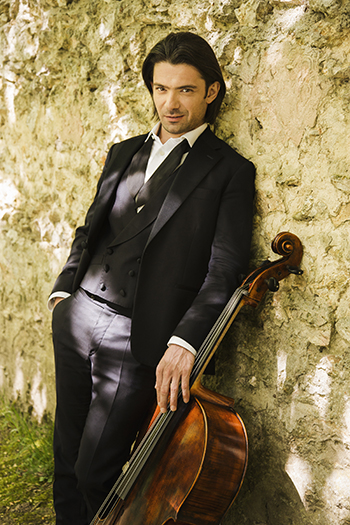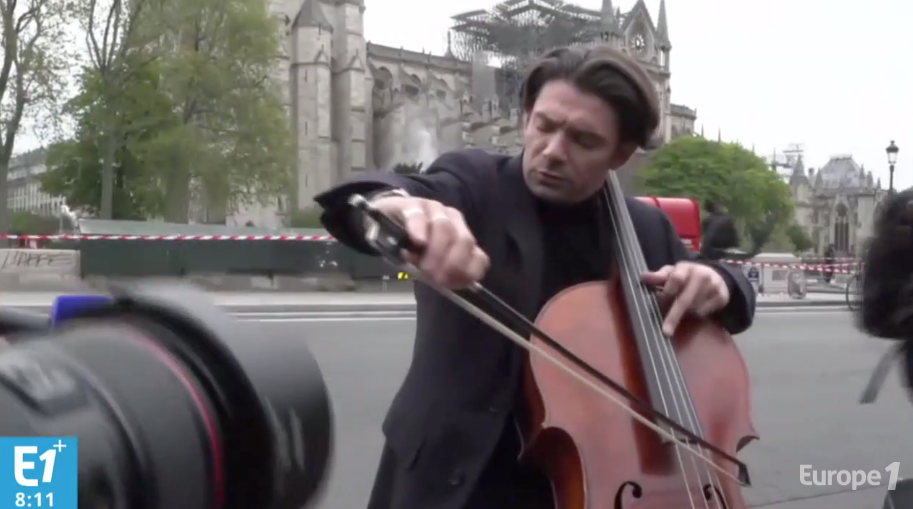by Mike Telin

On Saturday, July 27 at 8:00 pm at Blossom Music Center, Gautier Capuçon will once again join The Cleveland Orchestra in a performance of the same Concerto. Under the direction of Gemma New (replacing Bramwell Tovey), the program will also include Sibelius’ Finlandia as well as Elgar’s Enigma Variations in a side-by-side with Kent Blossom Music Festival Chamber Orchestra. That ensemble will present a pre-concert program at 7:00 pm led by Vinay Parameswaren, which features Mendelssohn’s Hebrides Overture and Ravel’s Suite from Mother Goose. Tickets are available online.
“It’s been too long since I’ve been there,” Capuçon said by telephone from Tanglewood. “The Cleveland Orchestra is, of course, one of the best in the world and we have had many amazing concerts together. That’s why I’m excited to come back to play this incredible piece with all those phenomenal musicians.”
Written when the composer was 37, Capuçon said that he finds it interesting that people don’t think of the Concerto as being a Romantic work, in part because Saint-Saëns dates from 1835 until 1921. “He lived to be very old, but this piece was written in 1872, so it does come from the Romantic period.”
The cellist noted that Saint-Saëns was an organist and his writing for orchestra is “absolutely great. He knows how to write for the cello,” he said, adding that the Concerto is a piece that he loves to perform. “I think it’s also very fun to listen to. It’s very theatrical, with a lot of drama. I like the beginning — you can imagine the curtain going up on the stage, with the big chord in the orchestra, and straight away the cello comes in.”
He pointed out that the second movement theme is a simple waltz. “I think it is so beautiful and so delicate — you can imagine a child opening a music box. Then there is this frenetic, virtuosic last movement with a little section that is almost like a recitativo. For me, the ending is like the end of an opera.”
When not performing onstage, Capuçon can often be found in the recording studio — he has an exclusive contract with Erato (Warner Classics). In January of this year he released a disc of works by Schumann with conductor Bernard Haitink, pianist Martha Argerich, and his brother, violinist Renaud Capuçon. His 2018 album, Intuition, is a collection of short works that he called little jewels.
“This recording was a way for me to play pieces that were very important to me at different times in my life — from my first cello when I was four and a half, until now. I chose some pieces that people know very well — [Saint-Saëns’] The Swan, [Massenet’s] Méditation from Thaïs — but also some pieces that are lesser known but are personal to me.”
One such work is a Scott Joplin rag. “This is a remembering of my time in Vienna when I studied with Heinrich Schiff, who passed away a few years ago. He was very dear to me and I learned so much from him. He would often play this piece as an encore, so it is linked to him and my time in Vienna.” Click here for a video.
Speaking of videos, there are some stunning ones accompanying a few other pieces on the album. The Swan finds him on a snow-capped mountain while Méditation from Thaïs is centered around the sea coast. And he performs Fauré’s Après un rêve, on the wing of a jetliner at Charles de Gaulle Airport.
When asked about the locations of the videos, he said, “I love adventure and I love to take my cello to unusual places. The view on the mountain or the wing of the plane gives you the feeling that you are completely alone. The sensation is quite incredible. It’s also fantastic because those pieces are linked to experiences that I had. So, when I play the swan, I close my eyes and I feel the cold of the glacier.”
Was he ever afraid of slipping off the wing of the airplane? “You know,” he said laughing, “that was such a great experience, and my daughter is in the video so it’s a great memory for her. But to go on the wing of the plane was exciting. I enjoyed making the recording so much that I’m now thinking about doing number two because there’s so many pieces that I want to share.”
Another project that is near to the cellist’s heart is his Classe d’Excellence de Violincelle – Fondation Louis Vuitton. For the past five years, Capuçon has invited six young cellists from around the world to come to Pairs to take part in master classes, share musical experiences, and learn from music business professionals such as concert promoters, managers, recording producers, and engineers, as well as physical therapists who give advice on keeping the body healthy.
“This is a fantastic project,” Capuçon said. “When the Fondation opened five years ago — it’s a stunning museum designed by Frank Gehry — they asked me to propose some projects and I gave them this one. Basically, we have six sessions of three or four days each year. The students are selected though auditions and everything is paid for by the foundation.”
The final concert always includes a commissioned work for seven cellos. On June 29, 2019, Capuçon and the participants gave the premiere of Bryce Dessner’s The Forest, a work inspired by the fire at Notre Dame Cathedral. Click here to watch the performance.
“The Forest is the name of the wooden roof of the Cathedral. It is also a link to the wood of the cello,” Capuçon said. “Dessner wanted to say that we are always in between things that we believe to be permanent, and things that are not. A place like Notre Dame, which is part of our French history, we think is eternal, but in life, nothing is permanent.”
Dessner’s musical material is based on the music of the late 12th-century composer Perotin, one of the first composers of the French School at Notre Dame. “It is a gorgeous piece,” Capuçon said. “When we premiered it, it was such a huge success that when the audience wanted an encore, I told them that we would love to play it again. They said yes, so we played it twice.”
Capuçon recalled the day of April 15, 2019. “I first heard about the fire on TV and I couldn’t believe what I was seeing, so I went there because I had to see with my own eyes. The thing is, you see it burning, but there is something that you don’t understand — how is it possible that such a piece of art and history is burning? I was with so many people — French, Parisians, tourists — everybody had tears in their eyes. The next day, I thought that as a musician the best way to share my feelings of sadness and hope would be with my cello. So, I went and played the Fauré’s Après un rêve.” Click here to see the video.
Published on ClevelandClassical.com July 22, 2019.
Click here for a printable copy of this article





